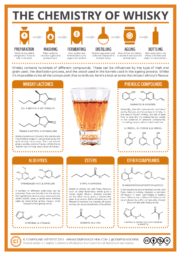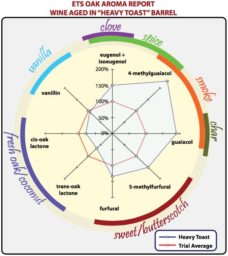
The Higher the Furfural Content, The Better The Whiskey! (Image: DalinYebo)
Furfural imparts a characteristic variously described as grainy, biscuity, or almond-like.
Nosing whiskey isn’t just an art, but a science [1]
While it’s probably true that many self-proclaimed experts are really hacks who’ve learned a lot of fancy vocabulary, nosing isn’t just an art, but a science.
DalinYebo‘s insight:
Whiskey is very complex chemically, and when we detect certain notes in it, that’s because it contains certain molecules. If a whiskey has pear notes, that’s because it has in it a dash of the same chemical that makes pears smell like pear. Although the range of fragrant compounds that can occur in whiskey is large, some of the more prevalent compounds can be broken down into a few groups:
Esters are a group of compounds mostly created during fermentation when fatty acids and alcohols produced by yeast combine with each other. Interactions between alcohols and fatty acids of different kinds lead to the creation of many different kinds of esters, each of which has a distinct aroma. For the most part, esters, especially short- and medium-chain esters, which are the most abundant, impart fruity notes. Long-chain esters, though, have a wider range, including cheesy and soapy aromas. A sub-group of esters are lactones, one of which is commonly called whiskey lactone. It has a coconut or wood aroma and comes from the oak whiskey is aged in.
Phenols, including phenol, guaiacol, and cresol, impart a range of smoky, rubbery, and medicinal flavours to whiskey. If that sounds like a description of a big Highland scotch, that’s because the major source of phenols is peat smoke. In nature, cresols are also found in human sweat and beaver castor glands!
Aldehydes are the source of a wide range of flavours, including furfural, which imparts a characteristic variously described as grainy, biscuity, or almond-like; and vanillin and cinnamaldehyde, which I’ll let you make your own assumptions about. Some of these compounds are produced during fermentation and distillation, while others are imparted during aging. Researchers have found that the presence of furfural, which, in whiskey, comes from charred oak, can be used to tell a straight whiskey apart from a blended whiskey coloured with caramel. If you’re ever feeling sheepish at a group tasting because you don’t taste the same thing everyone else does, keep this in mind: just as different notes are physically present in whiskey, everyone’s nose is slightly different. Some people, including skilled professional tasters, simply lack receptors for certain compounds. In fact, it’s been suggested that virtually everyone on earth lacks sensitivity to at least one smell. While there is biological variation in nasal acuity between different people, what’s far more important in tasting is practice, repetition, and learning to trust your own senses.
- Chemistry of Whisky
- Oak Aroma






